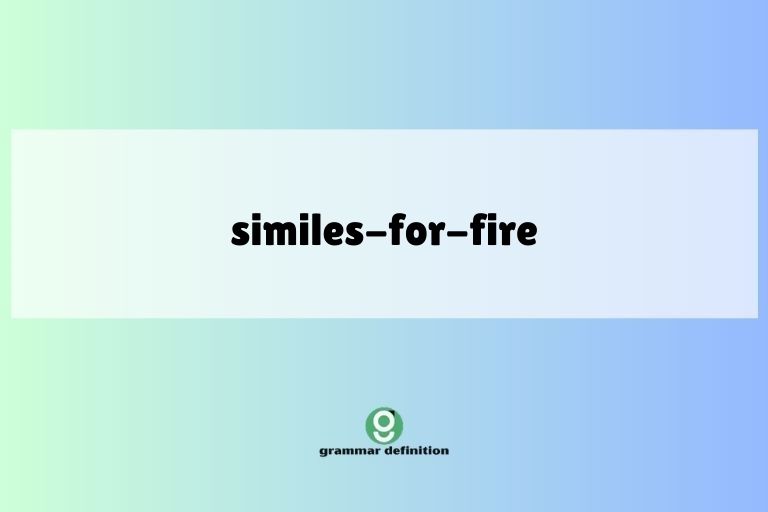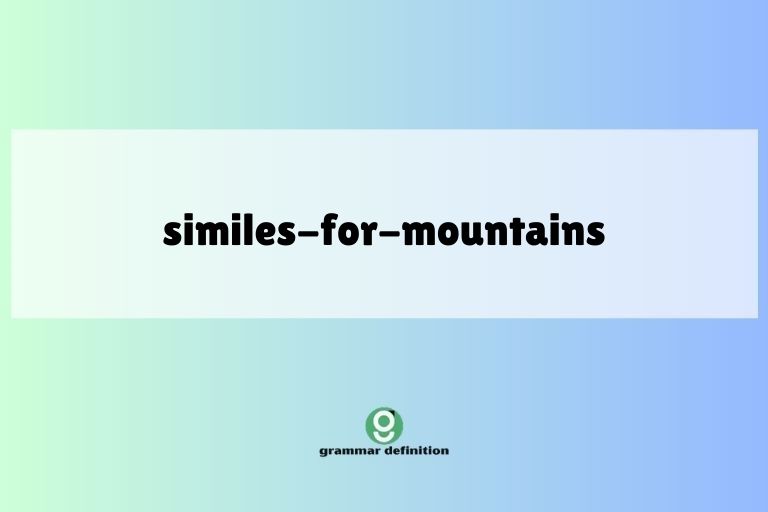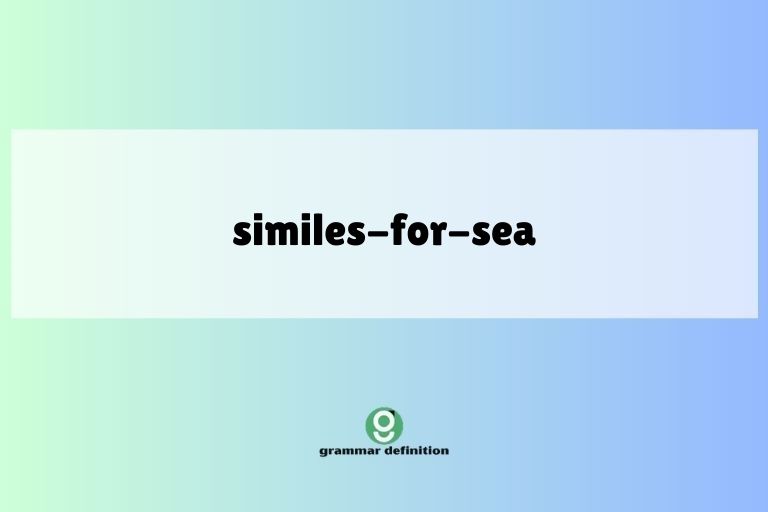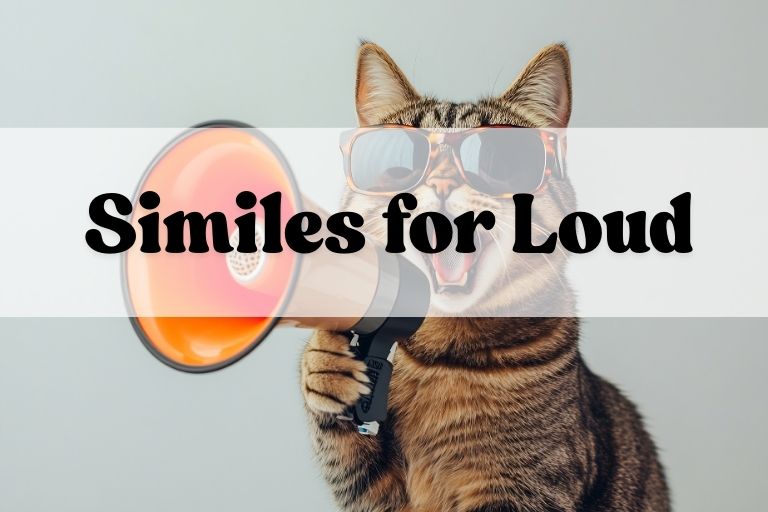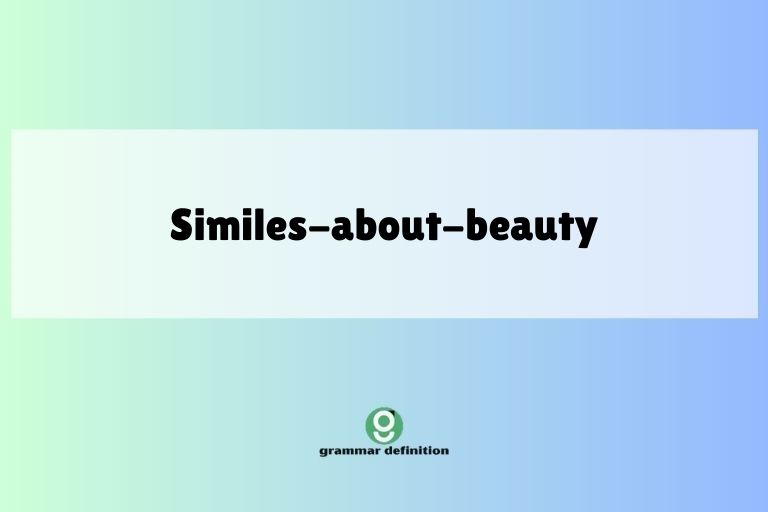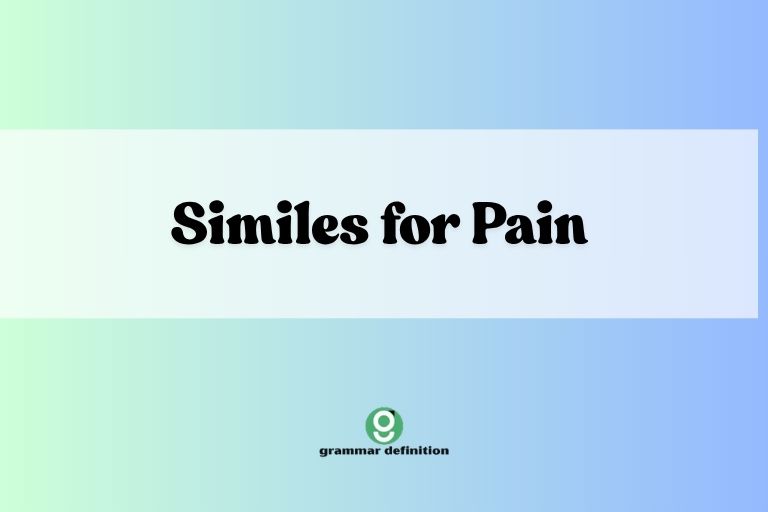Similes for Blue: Enhancing Your Descriptive Language
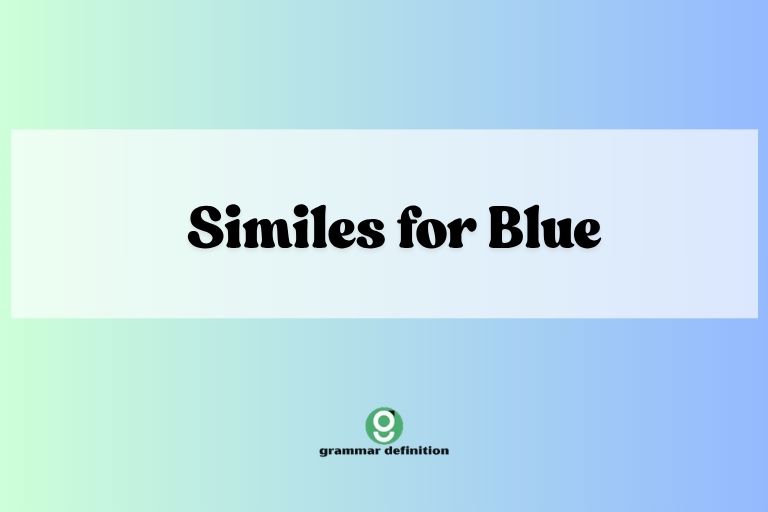
Understanding and using similes effectively is crucial for enriching your writing and speech. Similes allow you to create vivid comparisons, painting a clearer picture for your audience.
This article focuses specifically on similes that use the color blue as a point of comparison, demonstrating how these figurative language devices can add depth and nuance to your descriptions. Whether you’re a student learning grammar, a writer seeking to improve your prose, or simply someone interested in the intricacies of language, this guide will provide you with a comprehensive understanding of similes for blue.
By exploring various examples, structural breakdowns, and usage rules, you’ll gain the ability to craft compelling similes that evoke the color blue in imaginative and impactful ways. This article is designed to be accessible to learners of all levels, from beginners to advanced English speakers, offering practical exercises and addressing common mistakes to ensure mastery of this essential linguistic skill.
Table of Contents
- Introduction
- Definition of Simile
- Structural Breakdown of Similes
- Types of Similes for Blue
- Examples of Similes for Blue
- Usage Rules for Similes
- Common Mistakes with Similes
- Practice Exercises
- Advanced Topics: Metaphor vs. Simile
- FAQ
- Conclusion
Definition of Simile
A simile is a figure of speech that directly compares two different things using the words “like” or “as.” Its primary function is to create a vivid and relatable image in the reader’s or listener’s mind by associating an unfamiliar concept with something more familiar. Similes enhance understanding and make descriptions more engaging.
Similes fall under the broader category of figurative language, which includes metaphors, personification, and hyperbole. Unlike metaphors, which imply that one thing *is* another, similes explicitly state a comparison.
The comparison is based on a shared quality or characteristic between the two things being compared. The context in which a simile is used greatly influences its effectiveness.
A well-chosen simile can transform a mundane sentence into a memorable and impactful statement.
Structural Breakdown of Similes
The basic structure of a simile consists of three main components: the subject (the thing being described), the linking word (“like” or “as”), and the object of comparison (the thing it’s being compared to). Understanding this structure is essential for creating grammatically correct and effective similes.
Here’s a breakdown of the structure:
- Subject: The noun or pronoun that is being described.
- Linking Word: “Like” or “as.” These words explicitly indicate a comparison.
- Object of Comparison: The noun or pronoun that the subject is being compared to.
For example, in the simile “The sky was as blue as a sapphire,” “sky” is the subject, “as” is the linking word, and “sapphire” is the object of comparison. The simile suggests that the sky shares the same deep blue color as a sapphire.
The strength of a simile lies in the aptness of the comparison. A surprising or unusual comparison can be particularly effective, provided it is still logical and understandable.
Types of Similes for Blue
Similes for blue can be categorized based on the types of objects or concepts they use for comparison. These categories help to organize and understand the different ways in which the color blue can be evoked through figurative language.
Similes Based on Natural Elements
This category includes similes that compare something to natural elements that are often blue, such as the sky, the ocean, or certain flowers. These similes are often used to evoke feelings of peace, vastness, or tranquility.
Similes Based on Objects
This category involves comparisons to man-made objects that are typically blue, such as blue jeans, blue paint, or blue cars. These similes can be more specific and can evoke different associations depending on the object chosen.
Similes Based on Emotions
Blue is often associated with sadness or melancholy. Similes in this category use blue to describe emotional states, such as feeling “as blue as a sad song” or “like a blue mood washing over you.”
Similes Based on Gemstones
Certain gemstones, like sapphires and aquamarines, are well-known for their vibrant blue hues. These similes can be used to describe something as precious, beautiful, or captivatingly colored.
Examples of Similes for Blue
The following sections provide numerous examples of similes for blue, categorized by the type of comparison they employ. Each example is designed to illustrate how the color blue can be evoked through different figurative language techniques.
Similes Comparing to the Sky
The sky is a common point of reference for the color blue. These similes often evoke feelings of vastness, freedom, and peace.
Here is a table with examples:
| Simile | Explanation |
|---|---|
| Her eyes were as blue as a summer sky. | Describes eye color, evoking a sense of brightness and warmth. |
| The lake was as blue as the sky on a clear day. | Describes the lake’s color, suggesting clarity and serenity. |
| His mood was as blue as a cloudy sky. | Describes a somber mood, linking it to the gray-blue of a cloudy day. |
| The dress was like a piece of the evening sky. | Describes the dress’s color, evoking a sense of elegance and twilight. |
| The bird’s feathers were as blue as the morning sky. | Describes the bird’s feather color, implying vibrancy and freshness. |
| The paint on the wall was as blue as the midday sky. | Describes the paint’s shade, suggesting a bright, pure blue. |
| Her laughter was as rare as a blue moon in the sky. | Describes her laughter as infrequent and special. |
| The distant mountains were as blue as the horizon sky. | Describes the mountains’ color, suggesting distance and mystery. |
| His dreams were as blue as the endless sky above. | Describes his dreams as vast and limitless. |
| The scarf was as blue as the twilight sky. | Describes the scarf’s color, evoking a sense of calmness and dusk. |
| The pool water was as blue as the tropical sky. | Describes the pool water, suggesting a vibrant, inviting blue. |
| The old car was as blue as a faded sky. | Describes the car’s color, suggesting age and wear. |
| Her aura seemed as blue as a protective sky. | Describes her aura, evoking a sense of safety and peace. |
| The stained glass was as blue as a cathedral sky. | Describes the stained glass, suggesting reverence and beauty. |
| His eyes held a depth as blue as the night sky. | Describes his eyes, implying mystery and profundity. |
| The blueberries were as blue as a pre-dawn sky. | Describes the blueberries, suggesting a deep, rich color. |
| The ceramic tile was as blue as a Spanish sky. | Describes the tile, evoking a sense of warmth and vibrancy. |
| The smoke lingered, as blue as a distant sky. | Describes the smoke, suggesting ethereality and distance. |
| Her voice was as blue as a clear sky after rain. | Describes her voice, implying clarity and freshness. |
| The flag waved, as blue as a patriotic sky. | Describes the flag, evoking a sense of national pride. |
| The paint swatch was as blue as a child’s drawing of the sky. | Describes the paint swatch, suggesting simplicity and innocence. |
| His uniform was as blue as the naval sky. | Describes the uniform, evoking a sense of authority and discipline. |
| The icy glare was as blue as a winter sky. | Describes the glare, suggesting coldness and intensity. |
Similes Comparing to Water
Water, especially the ocean and lakes, is another common point of comparison for the color blue. These similes can evoke feelings of depth, mystery, and tranquility.
The following table illustrates some examples:
| Simile | Explanation |
|---|---|
| His eyes were as blue as the deep sea. | Describes eye color, suggesting depth and mystery. |
| The pool was like a sapphire sea. | Describes the pool’s color, evoking luxury and beauty. |
| Her dress flowed like the blue ocean waves. | Describes the dress’s movement and color, suggesting fluidity and grace. |
| The ink was as blue as the darkest ocean trench. | Describes the ink’s color, implying depth and intensity. |
| He felt as blue as a ship lost at sea. | Describes a feeling of loneliness and being lost. |
| The glass was as blue as the Caribbean Sea. | Describes the glass’s color, suggesting vibrancy and tropical beauty. |
| Her tears were as blue as the saline sea. | Describes her tears, metaphorically linking them to sadness. |
| The fabric was as blue as the calmest lake. | Describes the fabric’s color, suggesting peace and serenity. |
| His voice was as blue as the echoing sea. | Describes his voice, evoking a sense of vastness and resonance. |
| The paint shimmered like the blue surface of the water. | Describes the paint’s shimmer, suggesting movement and light. |
| The gemstone was as blue as the depths of the ocean. | Describes the gemstone’s color, implying rarity and value. |
| His mood was as turbulent as the blue stormy sea. | Describes his mood, suggesting unrest and intensity. |
| The scarf was as blue as a still ocean reflecting the sky. | Describes the scarf’s color, evoking a sense of peace and reflection. |
| Her gaze was as blue as the open sea. | Describes her gaze, suggesting openness and freedom. |
| The twilight was as blue as the merging sea and sky. | Describes the twilight, evoking a sense of transition and mystery. |
| The light in the room was as blue as underwater light. | Describes the light, suggesting a filtered, ethereal quality. |
| His spirit was as blue as the uncharted ocean. | Describes his spirit, implying adventure and exploration. |
| Her song was as blue as a siren’s call from the sea. | Describes her song, evoking allure and mystery. |
| The horizon was as blue as the meeting of the sky and sea. | Describes the horizon, suggesting vastness and continuity. |
| The depths of his knowledge were as blue as the unfathomed sea. | Describes his knowledge, implying vastness and complexity. |
| The ceramic bowl was as blue as the Aegean Sea. | Describes the bowl, suggesting a vibrant, Mediterranean blue. |
| His dreams were as blue as the coral reefs under the sea. | Describes his dreams, evoking vibrancy and hidden beauty. |
| The old map was as blue as a sailor’s memory of the sea. | Describes the map, suggesting nostalgia and history. |
Similes Comparing to Gemstones
Gemstones known for their blue color, such as sapphires, aquamarines, and blue topaz, provide a luxurious and evocative point of comparison. These similes often suggest beauty, rarity, and value.
Consider these examples:
| Simile | Explanation |
|---|---|
| Her eyes sparkled like blue sapphires. | Describes her eyes, suggesting brilliance and beauty. |
| The pendant was as blue as an aquamarine gem. | Describes the pendant’s color, evoking a sense of elegance and clarity. |
| His gaze was as cold as a blue topaz. | Describes his gaze, suggesting coolness and detachment. |
| The paint was as vibrant as a lapis lazuli stone. | Describes the paint’s color, implying richness and vibrancy. |
| Her dress shimmered like a thousand blue gems. | Describes the dress, suggesting opulence and radiance. |
| The necklace was as blue as the finest blue diamond. | Describes the necklace, evoking luxury and rarity. |
| His loyalty was as steadfast as a blue zircon. | Describes his loyalty, suggesting reliability and strength. |
| The light reflected like tiny blue jewels on the water. | Describes the light, evoking brilliance and beauty. |
| Her words were as precious as blue opals. | Describes her words, suggesting value and uniqueness. |
| The mosaic was as blue as a collection of rare gemstones. | Describes the mosaic, implying artistry and value. |
| The sculpture was as blue as a carved sapphire. | Describes the sculpture, suggesting artistry and preciousness. |
| His dreams were as blue as the deepest azurite. | Describes his dreams, evoking depth and intensity. |
| Her smile was as radiant as a blue star sapphire. | Describes her smile, suggesting brilliance and rarity. |
| The antique ring was as blue as a forgotten gemstone. | Describes the ring, evoking history and mystery. |
| His wisdom was as clear as a flawless blue crystal. | Describes his wisdom, suggesting clarity and purity. |
| The stained glass window was as blue as a celestial gemstone. | Describes the window, evoking reverence and beauty. |
| Her presence was as calming as a blue chalcedony. | Describes her presence, suggesting peace and tranquility. |
| The artifact was as blue as an ancient gemstone artifact. | Describes the artifact, evoking history and mystery. |
| His love was as deep as a vast deposit of blue gems. | Describes his love, implying depth and abundance. |
| The artwork was as blue as an artist’s dream of gemstones. | Describes the artwork, evoking creativity and beauty. |
| The beadwork was as blue as a sky full of gemstone stars. | Describes the beadwork, suggesting intricacy and brilliance. |
| The silk was as blue as the shimmer of a gemstone’s surface. | Describes the silk, evoking luxury and light. |
| His thoughts were as intricate as the facets of a blue gem. | Describes his thoughts, suggesting complexity and detail. |
Similes Comparing to Emotions (Blue as Sadness)
Blue is often associated with feelings of sadness, melancholy, or depression. These similes use the color blue to describe emotional states, adding depth and nuance to the description.
Here’s a table of examples:
| Simile | Explanation |
|---|---|
| He felt as blue as a mournful song. | Describes his feelings, suggesting sadness and sorrow. |
| Her heart was as blue as a winter’s day. | Describes her emotional state, evoking coldness and sadness. |
| His spirits were as blue as the depths of despair. | Describes his spirits, implying profound sadness. |
| She was as blue as a forgotten dream. | Describes her emotional state, suggesting loss and regret. |
| He felt as blue as a rainy afternoon. | Describes his feelings, evoking a sense of gloom and melancholy. |
| Her sadness was as blue as a silent tear. | Describes her sadness, suggesting quiet sorrow. |
| His loneliness was as blue as a solitary night. | Describes his loneliness, evoking isolation and solitude. |
| She was as blue as a melody of sorrow. | Describes her emotional state, suggesting musical sadness. |
| His memories were as blue as a faded photograph. | Describes his memories, evoking nostalgia and sadness. |
| The atmosphere was as blue as a melancholic poem. | Describes the atmosphere, suggesting pervasive sadness. |
| He felt as blue as a ship lost at sea. | Describes his feelings, evoking a sense of being lost and alone. |
| Her heart ached as blue as a bruise. | Describes her heart, suggesting emotional pain. |
| His hope was as faint as a blue whisper in the wind. | Describes his hope, evoking fragility and uncertainty. |
| She was as blue as a shadow in the moonlight. | Describes her emotional state, suggesting mystery and sadness. |
| His soul felt as blue as a forgotten promise. | Describes his soul, evoking regret and disappointment. |
| The silence was as blue as the absence of laughter. | Describes the silence, suggesting sadness and emptiness. |
| He felt as blue as a ghost of yesterday. | Describes his feelings, evoking nostalgia and sadness. |
| Her eyes were as blue as a well of unshed tears. | Describes her eyes, suggesting suppressed sadness. |
| His spirit was as blue as a fading echo. | Describes his spirit, evoking loss and transience. |
| The world seemed as blue as a distorted reflection. | Describes the world, suggesting sadness and unreality. |
| He was as blue as a lone wolf howling at the moon. | Describes his feelings, evoking isolation and sorrow. |
| Her voice was as blue as a sigh in the dark. | Describes her voice, suggesting sadness and resignation. |
| His dreams were as blue as a shipwreck on the ocean floor. | Describes his dreams, evoking loss and ruin. |
Similes Comparing to Blue Objects
Similes can also use specific blue objects as points of comparison. These objects can range from everyday items to more unusual or symbolic ones, adding specificity to the description.
Here’s a table with examples:
| Simile | Explanation |
|---|---|
| His jeans were as blue as a classic denim jacket. | Describes the jeans’ color, evoking casualness and familiarity. |
| The car was as blue as a police cruiser. | Describes the car’s color, suggesting authority and seriousness. |
| The paint was as blue as a Smurf’s skin. | Describes the paint’s color, evoking playfulness and childhood. |
| Her hat was as blue as a robin’s egg. | Describes the hat’s color, suggesting delicateness and spring. |
| The bottle was as blue as a Bombay Sapphire gin bottle. | Describes the bottle’s color, evoking sophistication and clarity. |
| His tie was as blue as a power suit. | Describes the tie’s color, suggesting professionalism and confidence. |
| The curtains were as blue as a Tiffany’s box. | Describes the curtains’ color, evoking luxury and elegance. |
| The toy was as blue as a Lego brick. | Describes the toy’s color, suggesting playfulness and simplicity. |
| The envelope was as blue as a postcard from paradise. | Describes the envelope’s color, evoking travel and relaxation. |
| Her umbrella was as blue as a clear rain slicker. | Describes the umbrella’s color, suggesting practicality and style. |
| The ceramic mug was as blue as a Delftware piece. | Describes the mug, evoking tradition and artistry. |
| The neon sign was as blue as a retro diner. | Describes the sign, suggesting nostalgia and vibrancy. |
| His shirt was as blue as a chambray work shirt. | Describes his shirt, evoking simplicity and durability. |
| Her phone case was as blue as an electric guitar. | Describes the phone case, suggesting modernity and energy. |
| The notebook was as blue as a school binder. | Describes the notebook, evoking education and organization. |
| The headphones were as blue as a gaming headset. | Describes the headphones, suggesting entertainment and technology. |
| His backpack was as blue as a hiking pack. | Describes his backpack, evoking adventure and exploration. |
| Her shoes were as blue as a pair of Converse sneakers. | Describes her shoes, suggesting casualness and youthfulness. |
| The blanket was as blue as a cozy throw. | Describes the blanket, evoking warmth and comfort. |
| The scarf was as blue as an airline blanket. | Describes the scarf, suggesting travel and comfort. |
| His car was as blue as a vintage Mustang. | Describes his car, evoking nostalgia and style. |
| The walls were as blue as a nautical themed room. | Describes the walls, suggesting the sea and relaxation. |
| The vase was as blue as a piece of art glass. | Describes the vase, evoking artistry and elegance. |
Usage Rules for Similes
Using similes effectively requires adherence to certain grammatical and stylistic rules. While similes offer creative freedom, understanding these rules ensures clarity and avoids common pitfalls.
- Use “like” or “as”: Always use either “like” or “as” to explicitly indicate the comparison. Omitting these words transforms the simile into a metaphor.
- Compare dissimilar things: The two things being compared should be different enough to make the comparison interesting, but similar enough in some aspect to make it meaningful.
- Ensure clarity: The comparison should be clear and easily understood. Avoid obscure or overly complex comparisons that might confuse the reader.
- Avoid clichés: While some common similes are effective, try to avoid overused phrases that have lost their impact (e.g., “as blue as the sky” can be improved with more specific comparisons).
- Consider context: The appropriateness of a simile depends on the context in which it is used. A simile that works well in poetry might not be suitable for a technical report.
For example, instead of saying “The sky was blue,” you could say “The sky was as blue as a robin’s egg,” which adds a specific shade of blue and evokes a sense of spring. Always ensure that your similes enhance the description and add value to the writing.
Common Mistakes with Similes
Several common mistakes can detract from the effectiveness of similes. Recognizing and avoiding these errors is crucial for mastering the art of simile creation.
Here’s a breakdown of common mistakes and how to correct them:
| Mistake | Incorrect Example | Correct Example | Explanation |
|---|---|---|---|
| Using a metaphor instead of a simile | The sky was a blue sapphire. | The sky was as blue as a sapphire. | Metaphors imply equivalence, while similes explicitly state a comparison using “like” or “as.” |
| Comparing similar things | The car was as blue as a blue car. | The car was as blue as the summer sky. | Similes should compare dissimilar things to create a more vivid image. |
| Using clichés | The ocean was as blue as the sea. | The ocean was as blue as a peacock’s feather. | Avoid overused similes by finding more original and descriptive comparisons. |
| Creating unclear comparisons | His mood was as blue as a feeling. | His mood was as blue as a mournful song. | Ensure the comparison is specific and easily understood. |
| Misusing “like” and “as” | He runs as fast like a cheetah. | He runs as fast as a cheetah. | Use “like” to compare nouns and pronouns; use “as” to compare clauses or phrases. |
| Inconsistent tense | The water is as blue as the sky was. | The water is as blue as the sky is. | Maintain consistent tense throughout the simile. |
| Awkward wording | The shirt was blue like blue. | The shirt was as blue as a cornflower petal. | Ensure the simile flows smoothly and sounds natural. |
By avoiding these common mistakes, you can ensure that your similes are clear, effective, and add depth to your writing.
Practice Exercises
To solidify your understanding of similes for blue, complete the following exercises. Each exercise focuses on different aspects of simile creation and usage.
Answers are provided at the end of this section.
Exercise 1: Identifying Similes
Identify the similes in the following sentences:
| Question | Answer |
|---|---|
| 1. The lake was as blue as a sapphire. | The lake was as blue as a sapphire. |
| 2. His eyes were blue pools of water. | (This is a metaphor, not a simile) |
| 3. She felt as blue as a rainy day. | She felt as blue as a rainy day. |
| 4. The car, a blue streak, sped past. | (This uses “blue” as an adjective, not a simile) |
| 5. The sky looked like a blue canvas. | The sky looked like a blue canvas. |
| 6. He was blue with sadness. | (This uses “blue” as an adjective, not a simile) |
| 7. Her dress flowed like the blue ocean. | Her dress flowed like the blue ocean. |
| 8. The room was a blue haven. | (This is a metaphor, not a simile) |
| 9. His mood was as blue as a sad song. | His mood was as blue as a sad song. |
| 10. The bird was blue. | (This is a simple description, not a simile) |
Exercise 2: Completing Similes
Complete the following similes with an appropriate object of comparison:
| Question | Answer |
|---|---|
| 1. Her eyes were as blue as _____. | Her eyes were as blue as the summer sky. |
| 2. The water was like _____. | The water was like a sapphire sea. |
| 3. He felt as blue as _____. | He felt as blue as a mournful song. |
| 4. The dress was as blue as _____. | The dress was as blue as a twilight sky. |
| 5. His mood was as blue as _____. | His mood was as blue as a cloudy day. |
| 6. The ink was as blue as _____. | The ink was as blue as the deep ocean. |
| 7. The gemstone was as blue as _____. | The gemstone was as blue as a blue topaz. |
| 8. Her voice was as blue as _____. | Her voice was as blue as a quiet sea. |
| 9. The scarf was as blue as _____. | The scarf was as blue as a clear lake. |
| 10. The paint was as blue as _____. | The paint was as blue as a robin’s egg. |
Exercise 3: Creating Your Own Similes
Create your own similes for the following subjects, using the color blue as a point of comparison:
| Subject | Your Simile |
|---|---|
| 1. A sad feeling | A sad feeling was as blue as a long, lonely night. |
| 2. A clear sky | A clear sky was as blue as a polished sapphire. |
| 3. A deep ocean | A deep ocean was as blue as the twilight zone. |
| 4. A beautiful dress | A beautiful dress was as blue as a peacock’s train. |
| 5. Cold eyes | Cold eyes were as blue as glacial ice. |
| 6. A calm lake | A calm lake was as blue as a still summer sky. |
| 7. A piece of art | A piece of art was as blue as a Monet painting. |
| 8. A child’s toy | A child’s toy was as blue as a Lego brick. |
| 9. A winter day | A winter day was as blue as a frozen lake. |
| 10. His thoughts | His thoughts were as blue as the distant horizon. |
Advanced Topics: Metaphor vs. Simile
While both similes and metaphors are figures of speech that make comparisons, they differ in their approach. A simile explicitly states a comparison using “like” or “as,” while a metaphor implies a comparison by stating that one thing *is* another. Understanding this distinction is crucial for advanced writing and analysis.
For example, “The sky was as blue as a sapphire” is a simile, while “The sky was a blue sapphire” is a metaphor. The metaphor is more direct and assertive, suggesting a complete equivalence between the sky and a sapphire.
Similes are often considered less forceful than metaphors, but they provide a clearer and more direct comparison. Metaphors, on the other hand, can be more evocative and imaginative, but they require more interpretation from the reader.
The choice between a simile and a metaphor depends on the desired effect. If you want to make a clear and straightforward comparison, a simile is often the best choice.
If you want to create a more evocative and imaginative image, a metaphor might be more effective. Experiment with both techniques to see which one works best for your writing style and the specific context.
FAQ
-
What is the difference between a simile and a metaphor?
A simile uses “like” or “as” to make a direct comparison, while a metaphor implies a comparison by stating that one thing *is* another. For example, “The sky is like a blue canvas” (simile) versus “The sky is a blue canvas” (metaphor).
-
Why use similes in writing?
Similes enhance descriptions, create vivid imagery, and make writing more engaging and understandable. They allow you to connect abstract concepts with familiar images, making the text more relatable.
-
How can I avoid using clichés in my similes?
To avoid clichés, try to think of unique and specific comparisons. Instead of saying “as blue as the sky,” consider “as blue as a robin’s egg” or “as blue as a twilight ocean.”
-
Can a simile be too complex?
Yes, a simile can be too complex if the comparison is obscure or difficult to understand. The goal is to enhance clarity, not to confuse the reader. Keep your similes straightforward and relevant to the context.
-
Are similes only for descriptive writing?
No, similes can be used in various types of writing, including narrative, persuasive, and even technical writing, to clarify concepts and make the text more engaging.
Conclusion
Mastering the use of similes for the color blue can significantly enhance your descriptive writing and communication skills. By understanding the structure, types, and usage rules of similes, you can create vivid and engaging comparisons that evoke the color blue in imaginative and impactful ways.
Remember to avoid common mistakes, practice regularly, and experiment with different comparisons to find your unique voice. Whether you’re describing a serene landscape, a complex emotion, or a striking object, similes provide a powerful tool for bringing your words to life and connecting with your audience on a deeper level.
So, embrace the versatility of similes, and let your creativity flow as you paint the world with the many shades of blue.

